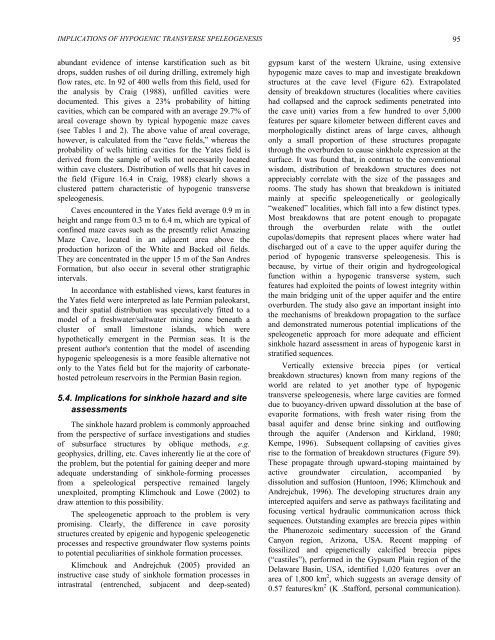Download PDF - Speleogenesis
Download PDF - Speleogenesis
Download PDF - Speleogenesis
You also want an ePaper? Increase the reach of your titles
YUMPU automatically turns print PDFs into web optimized ePapers that Google loves.
IMPLICATIONS OF HYPOGENIC TRANSVERSE SPELEOGENESIS<br />
abundant evidence of intense karstification such as bit<br />
drops, sudden rushes of oil during drilling, extremely high<br />
flow rates, etc. In 92 of 400 wells from this field, used for<br />
the analysis by Craig (1988), unfilled cavities were<br />
documented. This gives a 23% probability of hitting<br />
cavities, which can be compared with an average 29.7% of<br />
areal coverage shown by typical hypogenic maze caves<br />
(see Tables 1 and 2). The above value of areal coverage,<br />
however, is calculated from the “cave fields,” whereas the<br />
probability of wells hitting cavities for the Yates field is<br />
derived from the sample of wells not necessarily located<br />
within cave clusters. Distribution of wells that hit caves in<br />
the field (Figure 16.4 in Craig, 1988) clearly shows a<br />
clustered pattern characteristic of hypogenic transverse<br />
speleogenesis.<br />
Caves encountered in the Yates field average 0.9 m in<br />
height and range from 0.3 m to 6.4 m, which are typical of<br />
confined maze caves such as the presently relict Amazing<br />
Maze Cave, located in an adjacent area above the<br />
production horizon of the White and Backed oil fields.<br />
They are concentrated in the upper 15 m of the San Andres<br />
Formation, but also occur in several other stratigraphic<br />
intervals.<br />
In accordance with established views, karst features in<br />
the Yates field were interpreted as late Permian paleokarst,<br />
and their spatial distribution was speculatively fitted to a<br />
model of a freshwater/saltwater mixing zone beneath a<br />
cluster of small limestone islands, which were<br />
hypothetically emergent in the Permian seas. It is the<br />
present author's contention that the model of ascending<br />
hypogenic speleogenesis is a more feasible alternative not<br />
only to the Yates field but for the majority of carbonatehosted<br />
petroleum reservoirs in the Permian Basin region.<br />
5.4. Implications for sinkhole hazard and site<br />
assessments<br />
The sinkhole hazard problem is commonly approached<br />
from the perspective of surface investigations and studies<br />
of subsurface structures by oblique methods, e.g.<br />
geophysics, drilling, etc. Caves inherently lie at the core of<br />
the problem, but the potential for gaining deeper and more<br />
adequate understanding of sinkhole-forming processes<br />
from a speleological perspective remained largely<br />
unexploited, prompting Klimchouk and Lowe (2002) to<br />
draw attention to this possibility.<br />
The speleogenetic approach to the problem is very<br />
promising. Clearly, the difference in cave porosity<br />
structures created by epigenic and hypogenic speleogenetic<br />
processes and respective groundwater flow systems points<br />
to potential peculiarities of sinkhole formation processes.<br />
Klimchouk and Andrejchuk (2005) provided an<br />
instructive case study of sinkhole formation processes in<br />
intrastratal (entrenched, subjacent and deep-seated)<br />
gypsum karst of the western Ukraine, using extensive<br />
hypogenic maze caves to map and investigate breakdown<br />
structures at the cave level (Figure 62). Extrapolated<br />
density of breakdown structures (localities where cavities<br />
had collapsed and the caprock sediments penetrated into<br />
the cave unit) varies from a few hundred to over 5,000<br />
features per square kilometer between different caves and<br />
morphologically distinct areas of large caves, although<br />
only a small proportion of these structures propagate<br />
through the overburden to cause sinkhole expression at the<br />
surface. It was found that, in contrast to the conventional<br />
wisdom, distribution of breakdown structures does not<br />
appreciably correlate with the size of the passages and<br />
rooms. The study has shown that breakdown is initiated<br />
mainly at specific speleogenetically or geologically<br />
“weakened” localities, which fall into a few distinct types.<br />
Most breakdowns that are potent enough to propagate<br />
through the overburden relate with the outlet<br />
cupolas/domepits that represent places where water had<br />
discharged out of a cave to the upper aquifer during the<br />
period of hypogenic transverse speleogenesis. This is<br />
because, by virtue of their origin and hydrogeological<br />
function within a hypogenic transverse system, such<br />
features had exploited the points of lowest integrity within<br />
the main bridging unit of the upper aquifer and the entire<br />
overburden. The study also gave an important insight into<br />
the mechanisms of breakdown propagation to the surface<br />
and demonstrated numerous potential implications of the<br />
speleogenetic approach for more adequate and efficient<br />
sinkhole hazard assessment in areas of hypogenic karst in<br />
stratified sequences.<br />
Vertically extensive breccia pipes (or vertical<br />
breakdown structures) known from many regions of the<br />
world are related to yet another type of hypogenic<br />
transverse speleogenesis, where large cavities are formed<br />
due to buoyancy-driven upward dissolution at the base of<br />
evaporite formations, with fresh water rising from the<br />
basal aquifer and dense brine sinking and outflowing<br />
through the aquifer (Anderson and Kirkland, 1980;<br />
Kempe, 1996). Subsequent collapsing of cavities gives<br />
rise to the formation of breakdown structures (Figure 59).<br />
These propagate through upward-stoping maintained by<br />
active groundwater circulation, accompanied by<br />
dissolution and suffosion (Huntoon, 1996; Klimchouk and<br />
Andrejchuk, 1996). The developing structures drain any<br />
intercepted aquifers and serve as pathways facilitating and<br />
focusing vertical hydraulic communication across thick<br />
sequences. Outstanding examples are breccia pipes within<br />
the Phanerozoic sedimentary succession of the Grand<br />
Canyon region, Arizona, USA. Recent mapping of<br />
fossilized and epigenetically calcified breccia pipes<br />
(“castiles”), performed in the Gypsum Plain region of the<br />
Delaware Basin, USA, identified 1,020 features over an<br />
area of 1,800 km 2 , which suggests an average density of<br />
0.57 features/km 2 (K .Stafford, personal communication).<br />
95
















